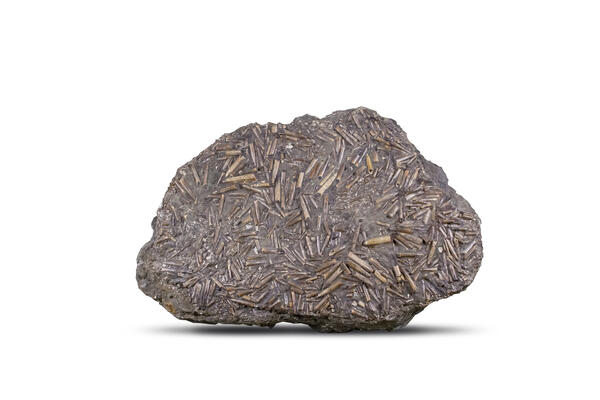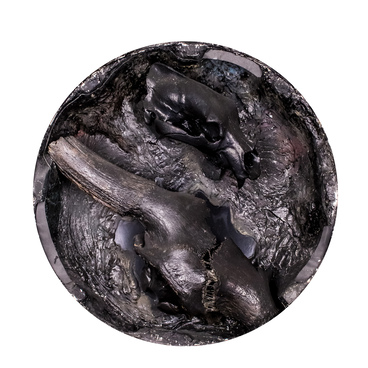Belemnite, or belemnitida is an order of cephalopods that lived in the seas of the Mesozoic era and are now completely extinct. Outwardly, they resembled modern squids, but unlike them, they had a shell consisting of three parts. Scientists called the middle conical part a phragmocone, a thin long protrusion at the back a pro-ostraca, and the pointed top that held the phragmocone a rostrum. As these mollusks evolved, the outer shell gradually concealed under soft tissues and became the inner one, skeleton-like.
Belemnites were predators and probably ate small mollusks. They had large eyes to catch the faint light on the sea bottom, cornified jaws, and ten limbs to capture prey. Their tentacles had strong chitinous hooks — usually small, up to five millimeters in length. However, some animals had sickle-shaped hooks ranging in size from three to eight centimeters. Scientists have found that they were not growing together with the whole mollusk body, but they developed on the adult male after puberty. The exact purpose of such hooks is unknown: they could serve as both a weapon and a device to hold a prey tight when hunting.
The belemnites rostrums were the strongest part of their shell. That is why they are better preserved to this day, and sometimes paleontologists find entire clusters of such fragments. They have a conical or cylinder shape, often resembling the tip of a spear or arrow. This specific shape gave the name to the mollusks themselves: it came from the word ‘belemnon’, which in ancient Greek meant a throwing weapon.
The concentric rings are usually clearly visible on the cross-sections of the rostrums, which can be used to determine the age of the mollusk. On the surface of these fossils, scientists find sometimes prints of blood vessels: this confirms that the rostrums were located not outside but under the soft tissues of the mollusk.
The belemnites rostrums were first mentioned in the works of a Greek naturalist Theophrastus, who lived in the 3–2 centuries BC. However, back then the scientist took them for stones. Pliny the Elder gave the name of the mollusks in the 1 century AD.
Belemnites were predators and probably ate small mollusks. They had large eyes to catch the faint light on the sea bottom, cornified jaws, and ten limbs to capture prey. Their tentacles had strong chitinous hooks — usually small, up to five millimeters in length. However, some animals had sickle-shaped hooks ranging in size from three to eight centimeters. Scientists have found that they were not growing together with the whole mollusk body, but they developed on the adult male after puberty. The exact purpose of such hooks is unknown: they could serve as both a weapon and a device to hold a prey tight when hunting.
The belemnites rostrums were the strongest part of their shell. That is why they are better preserved to this day, and sometimes paleontologists find entire clusters of such fragments. They have a conical or cylinder shape, often resembling the tip of a spear or arrow. This specific shape gave the name to the mollusks themselves: it came from the word ‘belemnon’, which in ancient Greek meant a throwing weapon.
The concentric rings are usually clearly visible on the cross-sections of the rostrums, which can be used to determine the age of the mollusk. On the surface of these fossils, scientists find sometimes prints of blood vessels: this confirms that the rostrums were located not outside but under the soft tissues of the mollusk.
The belemnites rostrums were first mentioned in the works of a Greek naturalist Theophrastus, who lived in the 3–2 centuries BC. However, back then the scientist took them for stones. Pliny the Elder gave the name of the mollusks in the 1 century AD.



